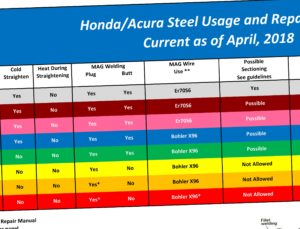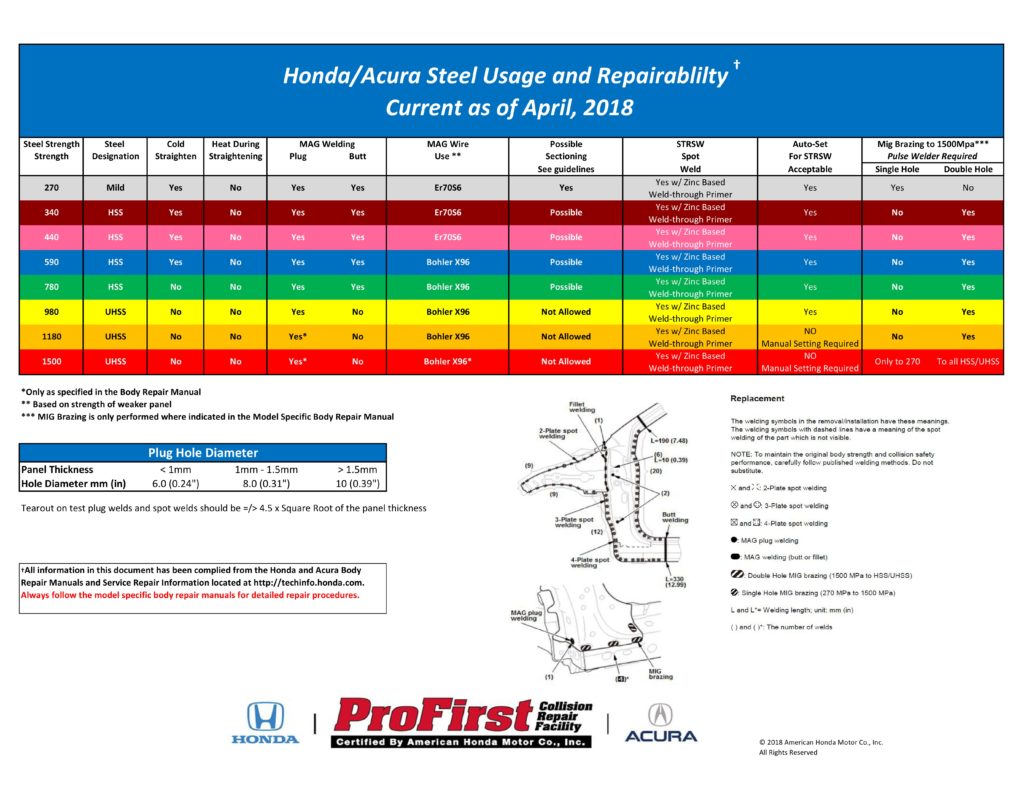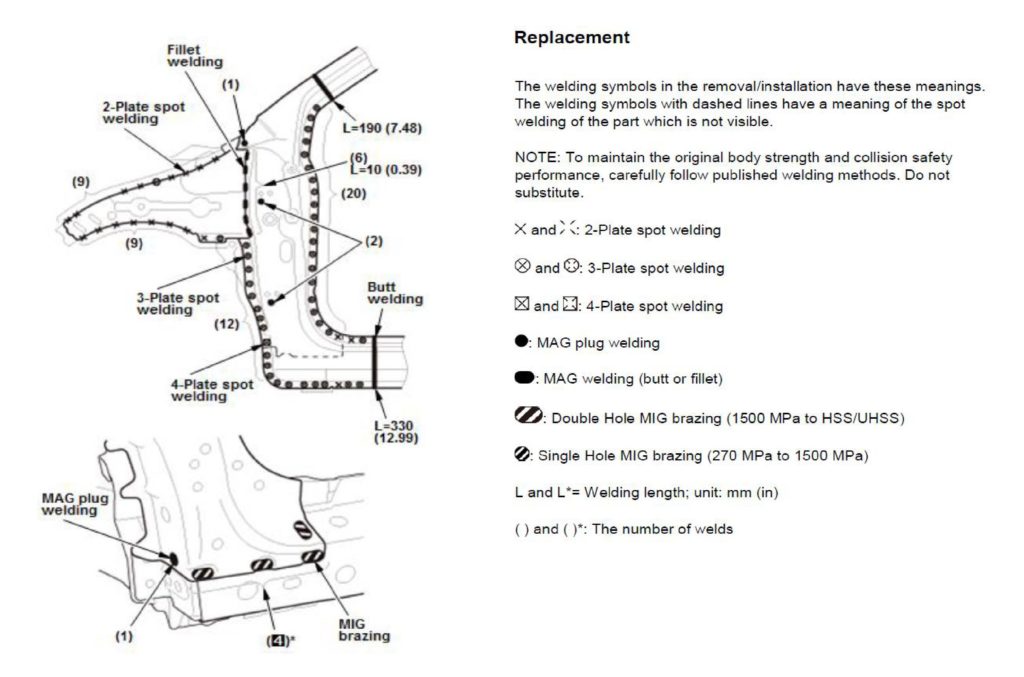
Honda releases auto body steel repairability, welding matrix on I-CAR
By onEducation | Repair Operations | Technology
While cautioning that auto body shops must always defer to the OEM repair procedures for the specific vehicle in front of them, Honda has released a handy general steel repairability matrix to the industry.
Honda shared the document with Honda ProFirst certified repairers and with the broader industry in conjunction with I-CAR, which posted the document Thursday on its Repairability Technical Support portal news feed.
“We are looking into posting it on the Free side of Service Express in the near future,” Honda collision marketing assistant manager Scott Kaboos wrote in an email Friday.
The matrix covers Honda’s steels from 270-megapascal mild steel — the only mild steel left on Honda vehicles — up to 1,500 MPa ultra-high-strength steel, and you’ll note that even the weaker higher-strength steels (340 MPa and 440 MPa) can’t be straightened with heat and aren’t always sectionable. At 780 MPa, you can’t even cold-straighten a part.
Welding
Much of the matrix deals with what welding is permissible and how best to accomplish it.
Have a slick new automatic squeeze-type resistance spot welder? You can use the automatic option on all steels through 980 MPa — but not on the gigapascal steels of 1,180 and 1,500 MPa. (We should point out I-CAR welding instructor and industry teacher Toby Chess‘ warning that auto settings aren’t infallible, and shops should still do a destructive test first.)
“Manual Setting Required,” Honda writes of the 1,180-and-up MPa steels.
The matrix also explains that squeeze-type resistance spot welding can receive zinc-based weld-through primer on all steel grades. However, note that no other welding is mentioned as a candidate for weld-through primer.
Honda in 2016 reported it found on other welds that the zinc can contaminate the weld pool, particularly when too much weld-through primer is used — “which it often is,” Honda collision instructional designer Chris Tobie said then. (And if the surface isn’t prepared correctly, the primer does you no good by flaking off anyway, he said.) A better option would be to make a weld, and then use a corrosion-inhibiting primer after the weld is done, Tobie said at the time.
Squeeze-type resistance spot welding is the exception to this no-zinc-primer rule because the joint holds “no matter what,” Tobie said then. You still have to properly prep the metal surfaces being welded, he said.
A July 2017 Body Repair News discusses those restrictions further.
The new steel matrix also tells you the necessary size of a test plug weld and spot weld’s tearout (greater than or equal to 4.5 times the square root (√) of the panel thickness) how wide a diameter plug holes generally need to have on actual car based upon the panel thickness.
It also discusses the parameters for MAG plug and butt welding and MIG brazing and lays out which MAG wire may be used.
This is crucial. For steels 590 MPa or stronger — grades which make up about half of the next-generation Honda Civic’s body in white, for example — shops can’t use their staple ER70S-6 wire. Its tensile strength is merely 482.63 MPa, which means the weld will fail before the adjacent steel does, which means the car won’t crash in the controlled manner Honda has designed.
A shop must instead upgrade to Bohler X96 wire, which is 980 MPa. Tobie in 2016 recommended shops not even bother using ER70S-6 wire at all, reasoning that swapping wire in and out of a welder runs the risk of the technician slipping up and using the weaker wire to weld steels it’s not strong enough to join and keep the vehicle crashworthy.
Finally, the matrix includes a handy key to the various welding symbols Honda uses in its OEM repair procedures.
This cheat sheet doesn’t replace the need for a shop to use Honda or Acura OEM repair procedures.
“Always follow the model specific body repair manuals for detailed repair procedures,” Honda warns, in red, bolded type.
But the matrix is still a valuable resource, and is the kind of thing that ought to be posted on the wall near body technicians or an estimator’s desk as a hedge against misreading or misunderstanding repair procedures and making a big mistake on an estimate or actual vehicle. It also could help an adjuster avoid incorrect assessments of what parts can be straightened or sectioned when predicting the severity of the loss.
“Honda/Acura Introduces Their Steel Usage and Repairability Matrix”
I-CAR, June 7, 2018
Honda Service Express repair procedure website
“Body Repair Manual Welding & Sectioning Guideline Revisions”
Honda, July 2017
Images:
While cautioning that shops must always defer to the OEM repair procedures for the specific vehicle in front of them, Honda has released a handy April 2018 steel repairability matrix to the collision repair industry. (Provided by Honda)
While cautioning that shops must always defer to the OEM repair procedures for the specific vehicle in front of them, Honda has released a handy April 2018 steel repairability matrix to the collision repair industry. The April 2018 document also contains this key to Honda welding symbols. (Provided by Honda)


